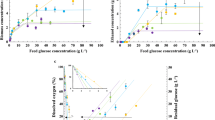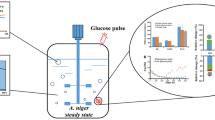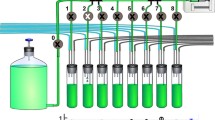Abstract
In chemostat cultures of Klebsiella pneumoniae (K. aerogenes) NCTC 418 we measured the concentrations of glucose and ammonium and we varied the ratio of the (limiting) concentrations of glucose and ammonium in the feed medium. By doing this at different dilution rates we found a range where growth rate varies with either concentration in the culture when the other concentration in the culture is held constant. This proves that within this range, dual-substrate controlled growth occurs. Dual substrate-controlled growth was accompanied by yield coefficients for glucose and for ammonium that were intermediate between the yield coefficients obtained for single glucose or single ammonium limitation. We quantified the control by either substrate in terms of the flux control coefficient with respect to that substrate, where flux refers to growth rate. Dualsubstrate controlled growth is reflected by the finding that both flux control coefficients exceed zero, simultaneously. In the transition of glucose to ammonium limitation, the control gradually shifts from glucose to ammonium.
Similar content being viewed by others
Abbreviations
- s:
-
Steady-state concentration of substrate in the culture
- Sr M:
-
Concentration of substrate in reservoir medium
- Y gδDWδmol-1 :
-
Yield
- D h-1 :
-
Dilution rate
- μ h−1 :
-
Specific growth rate
- μmax h−1 :
-
Maximal growth rate
- C μ2 :
-
Control coefficient, of s on μ
- J h-1 :
-
Rate or flux
- JATP mmolδgδDW-1δh-1 :
-
ATP synthesis rate
- a:
-
Anabolism
- c:
-
Catabolism
- l:
-
Leak
References
Bader FB (1984) Kinetics of double-substrate limited growth. In: Bazin MJ (ed) Microbial population dynamics. CRC Series in mathematical models in microbiology. CRC Press, Boca Baton, Florida, USA, pp 1–32
Baltzis BC, Fredrickson AG (1988) Limitation of growth rate by two complementary nutrients: some elementary but neglected considerations. Biotechnol Bioeng 31: 75–86
Buurman ET, Pennock J, Tempest DW, Teixeira de Mattos MJ, Neijssel OM (1989) Replacement of potassium ions by ammonium ions in different micro-organisms grown in potassiumlimited chemostat culture. Arch Microbiol 152: 58–63
Dijkhuizen L, Harder W (1984) Regulation of autotrophic and heterotrophic metabolism in Pseudomonas oxalaticus OX1. Growth on fructose and on mixtures of fructose and formate in batch and continuous cultures. J Gen Microbiol 130: 447–457
Dixon NM, Lovitt RW, Kell DB, Morris JG (1987) Effects of pCO2 on the growth and metabolism of Clostridium sporogenes NCIB 8053 in defined media. J Appl Bacteriol 63: 171–182
Duchars MG, Attwood MM (1989) The influence of C:N ratio in the growth medium on the cellular composition and regulation of enzyme activity in Hyphomicrobium X. J Gen Microbiol 135: 787–793
Egli Th, Quayle JR (1986) Influence of the carbon: nitrogen ratio of the growth medium on the cellular composition and the ability of the methylotrophic yeast Hansenula polymorpha to utilize mixed carbon sources. J Gen Microbiol 132: 1779–1788
Evans CGT, Herbert D, Tempest DW (1970) The continuous cultivation of micro-organisms. 2. Construction of a chemostat. In: Norris JR, Ribbons DW (eds) Methods in microbiology, vol 2. Academic Press, London New York, pp 277–327
Gräzer-Lampart SD, Egli Th, Hamer G (1986) Growth of Hyphomicrobium ZV620 in the chemostat: regulation of NH +4 -assimilating enzymes and cellular composition. J Gen Microbiol 132: 3337–3347
Groen AK, Van der Meer R, Westerhoff HV, Wanders RJA, Akerboom TPM, Tager JM (1982) Control of metabolic fluxes. In: Sies H (ed) Metabolic compartmentation. Academic Press, New York, pp 9–37
Harder W, Dijkhuizen L (1983) Physiological responses to nutrient limitation. Annu Rev Microbiol 37: 1–23
Heinrich R, Rapoport TA (1974) A linear steady-state treatment of enzymatic chains. General properties, control and effector strength. Eur J Biochem 42: 89–95
Herbert D (1961) The chemical composition of micro-organisms as a function of their environment. In: Mcynell CG, Gooder H (eds) Microbial reaction to the environment. 11th Symp Soc Gen Microbiol. Cambridge University Press, Cambridge, pp 391–416
Hueting S, Tempest DW (1979) Influence of the glucose input concentration on the kinetics of metabolite production by Klebsiella aerogenes NCTC 418, growing in chemostat culture in potassium-or ammonium-limited environments Arch Microbiol 123: 189–194
Kacser H, Burns JA (1973) The control of flux. In: Davies DD (ed) Rate control of biological processes. Cambridge University Press. Cambridge, pp 65–104
Kell DB (1987) Forces, fluxes and the control of microbial growth and metabolism. The twelfth Fleming lecture. J Gen Microbiol 133: 1651–1665
Kell DB, Westerhoff HV (1986) Metabolic control theory: its role in microbiology and biotechnology. FEMS Microbiol Rev 39: 305–320
Kell DB, Westerhoff HV, Van Dam K (1989) Control analysis of microbial growth and productivity. In: Baumberg S, Hunter I, Rhodes M (eds) 44th Symp Soc Gen Microbiol, Cambridge University Press, Cambridge, pp 61–93
Minkevich IG, Krynitskaya AY, Eroshin VK (1988) A double substrate limitation zone of continuous microbial growth. In: Kyslik P, Dawes EA, Krumphanzl V, Novak M (eds) Continuous culture. Academic Press, London, pp 171–184
Mulder MM, Teixeira de Mattos MJ, Postma PW, Van Dam K (1986) Energetic consequences of multiple K+ uptake systems in Escherichia coli. Biochim Biophys Acta 851: 223–228
Mulder MM, Van Der Gulden HML, Postma PW, Van Dam K (1988) Effect of macromolecular composition of microorganisms on the thermodynamic description of their growth. Biochim Biophys Acta 936: 406–412
Neijssel OM, Tempest DW (1979) The physiology of metabolite over-production. In: Bull AT, Ellwood DC, Ratledge C (eds) Microbial Technology. 29th Symp Soc Gen Microbiol. Cambridge University Press, Cambridge, pp 53–82
Rutgers M, Teixeira de Mattos MJ, Postma PW, Van Dam K (1987) Establishment of the steady state in glucose-limited chemostat cultures of Klebsiella pneumoniae. J Gen Microbiol 133: 445–453
Rutgers M, Balk PA, Van Dam K (1989a) Effect of concentration of substrates and products on the growth of Klebsiella pneumoniae NCTC 418 in chemostat cultures. Biochim Biophys Acta 977: 142–149
Rutgers M, Van Der Gulden HML, Van Dam K (1989b) Thermodynamic efficiency of bacterial growth calculated from growth yield of Pseudomonas oxalaticus OX1 in the chemostat. Biochim Biophys Acta 973: 302–307
Van Verseveld HW, Boon JP, Stouthamer AH (1979) Growth yields and the efficiency of oxidative phosphorylation of Paracoccus denitrificans during two (carbon) substrate-limited growth. Arch Microbiol 121: 213–223
Walsh K, Koshland DE (1985) Characterization of rate-controlling steps in vivo by use of an adjustable expression vector. Proc Natl Acad Sci 82: 3577–3581
Westerhoff HV, Van Dam K (1987) Thermodynamics and control of biological free-energy transduction. Elsevier, Amsterdam
Author information
Authors and Affiliations
Rights and permissions
About this article
Cite this article
Rutgers, M., Balk, P.A. & van Dam, K. Quantification of multiple-substrate controlled growth-simultaneous ammonium and glucose limitation in chemostat cultures of Klebsiella pneumoniae . Arch. Microbiol. 153, 478–484 (1990). https://doi.org/10.1007/BF00248430
Received:
Accepted:
Issue Date:
DOI: https://doi.org/10.1007/BF00248430




